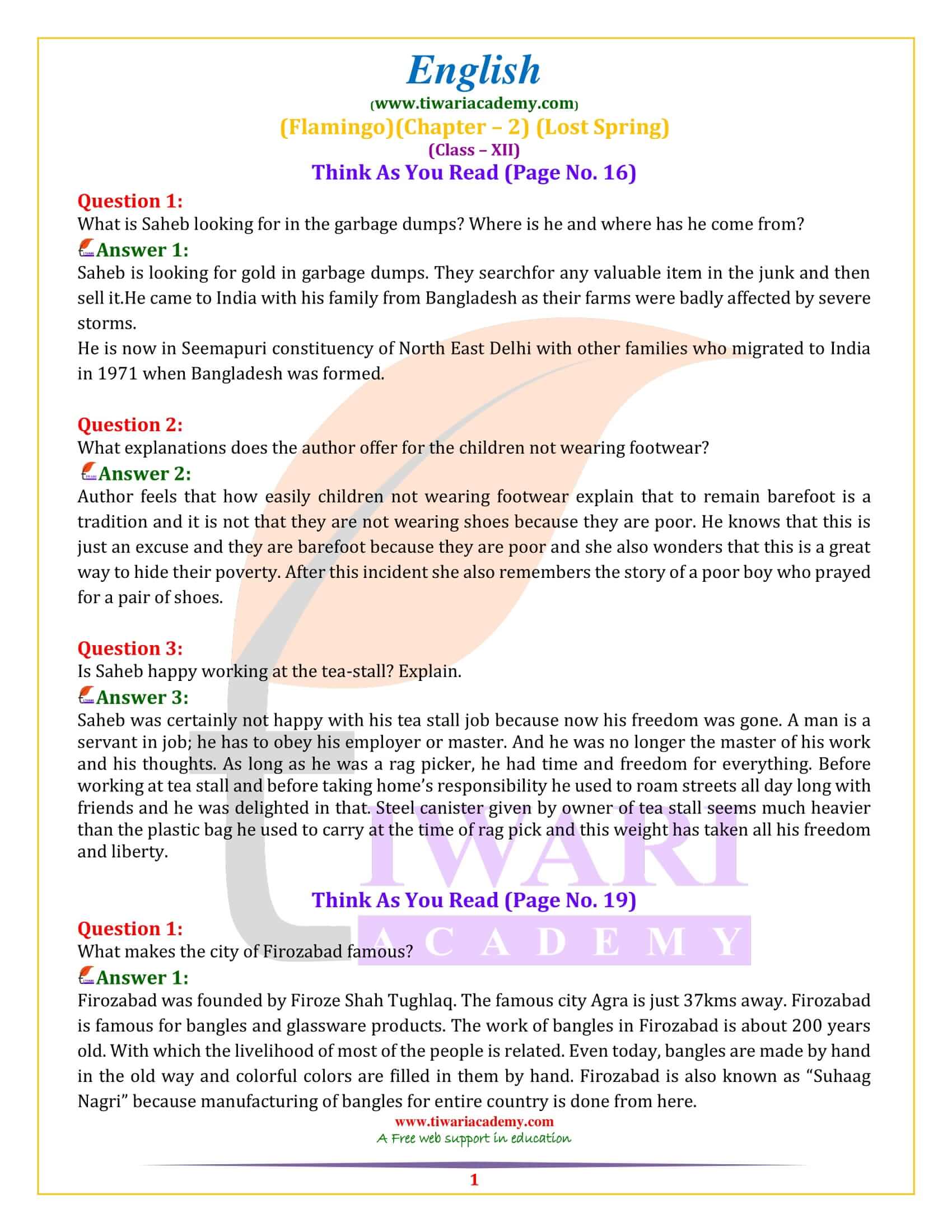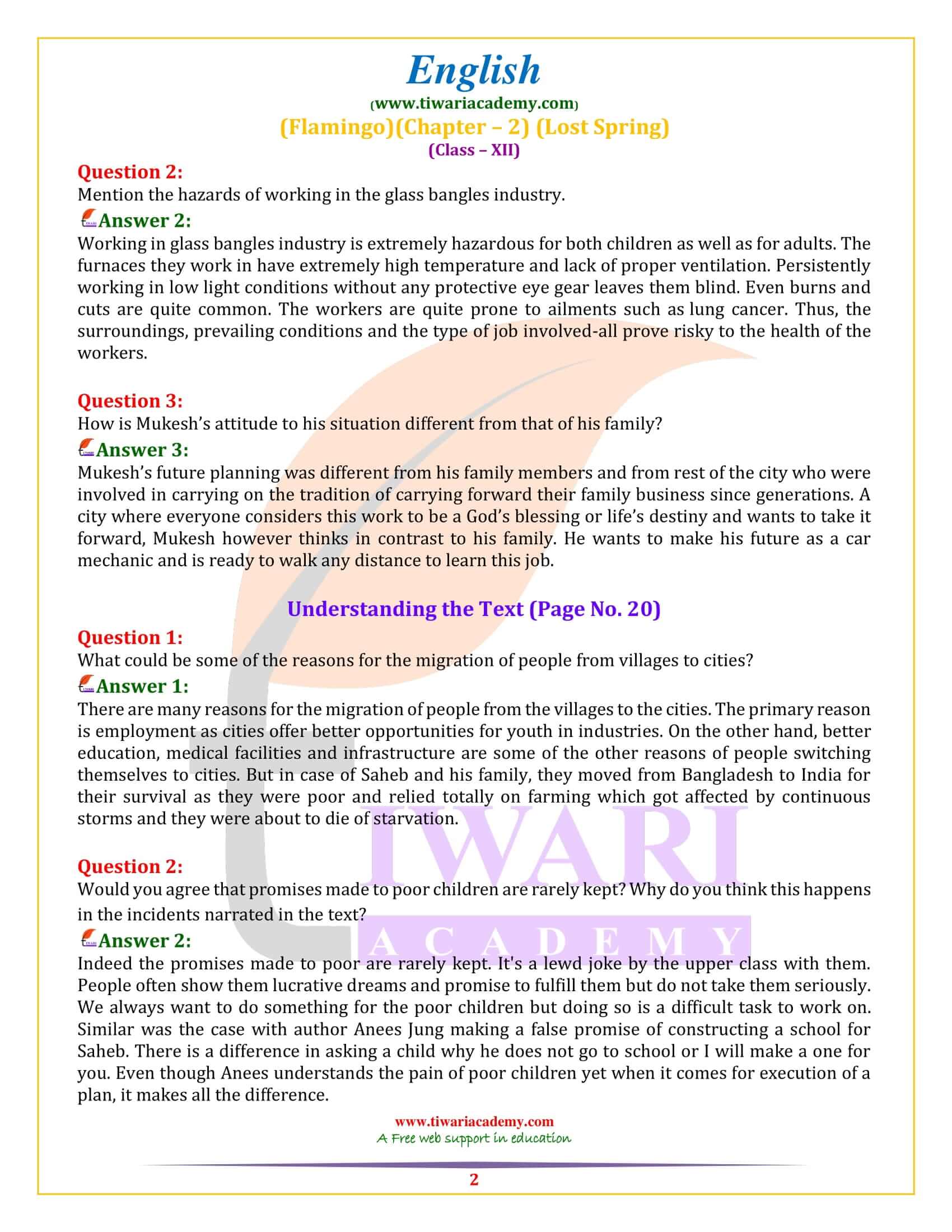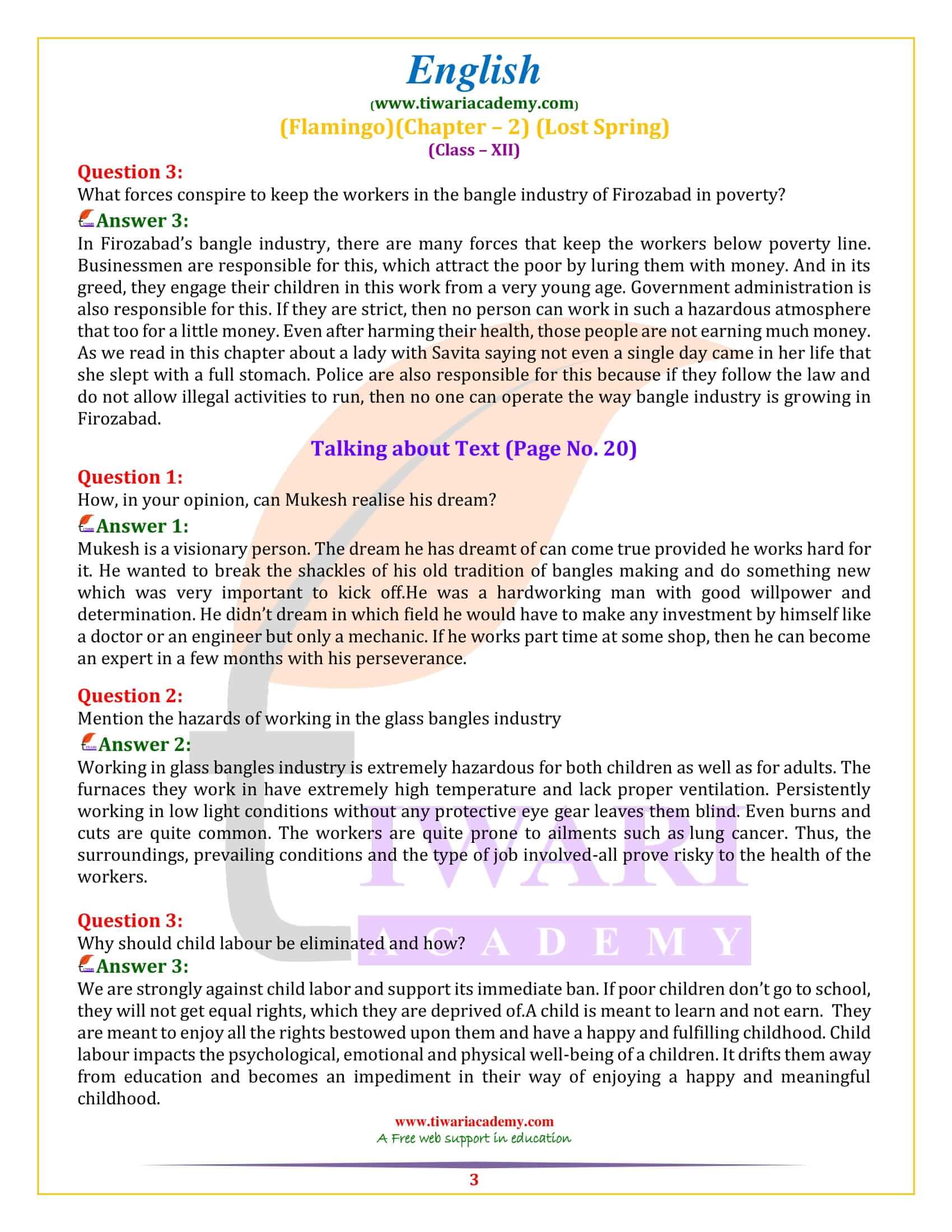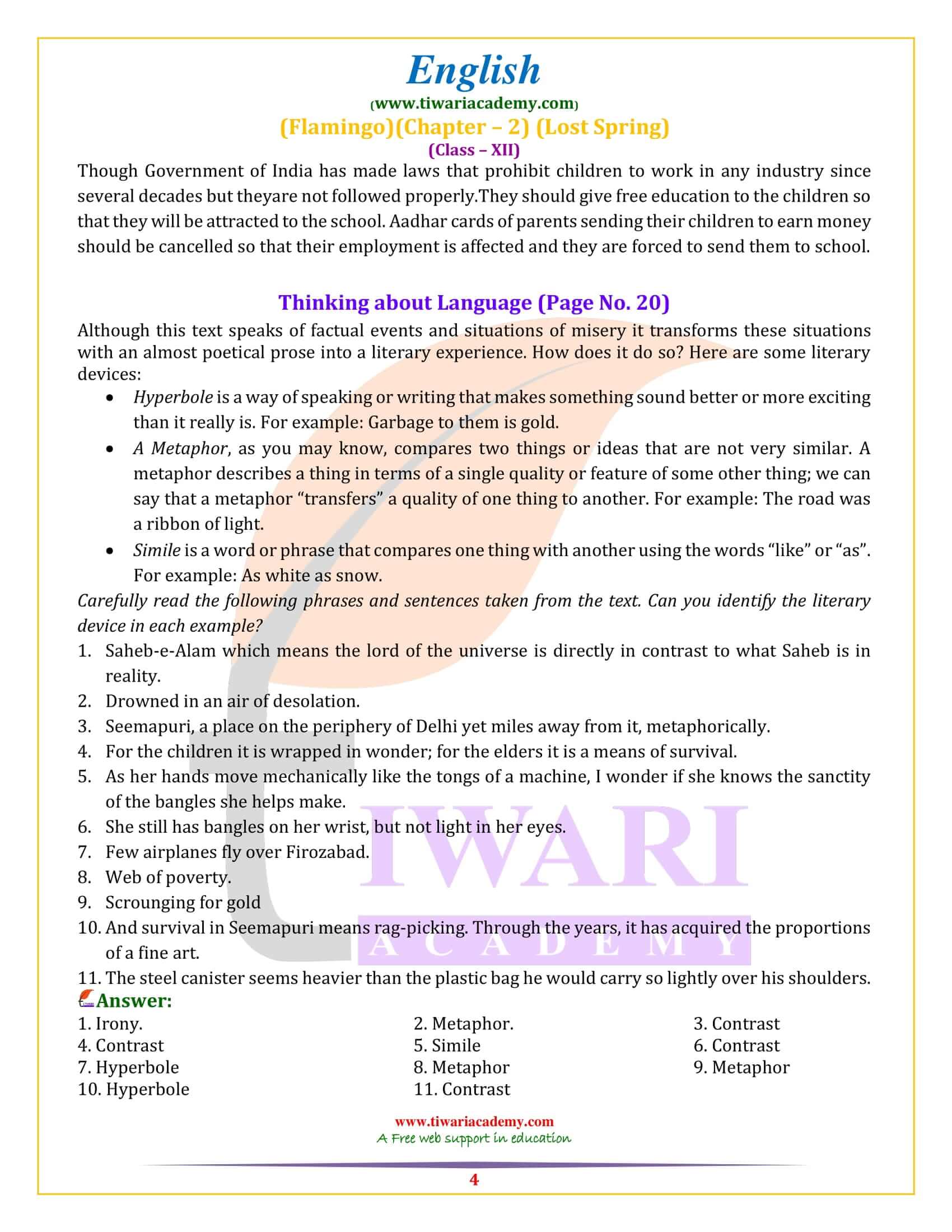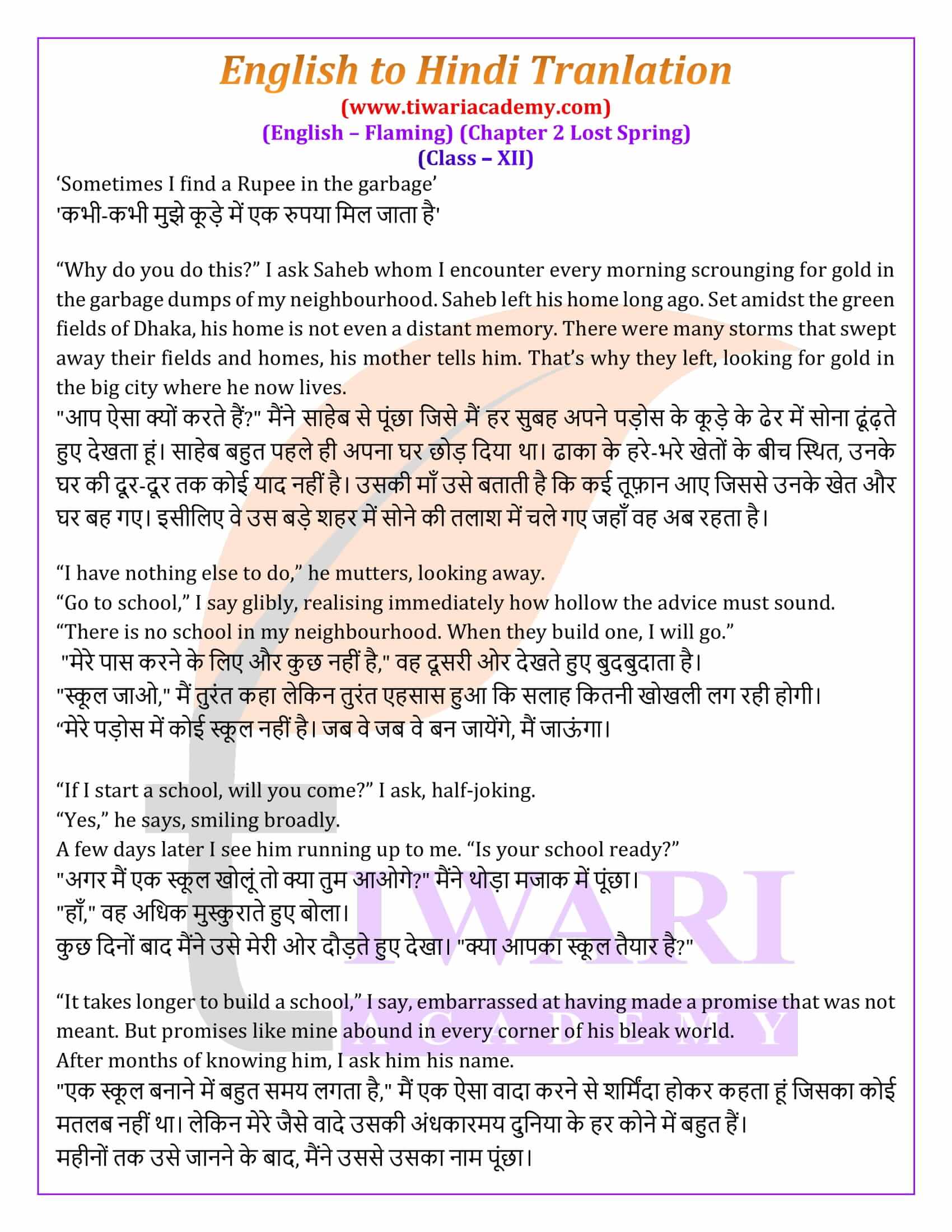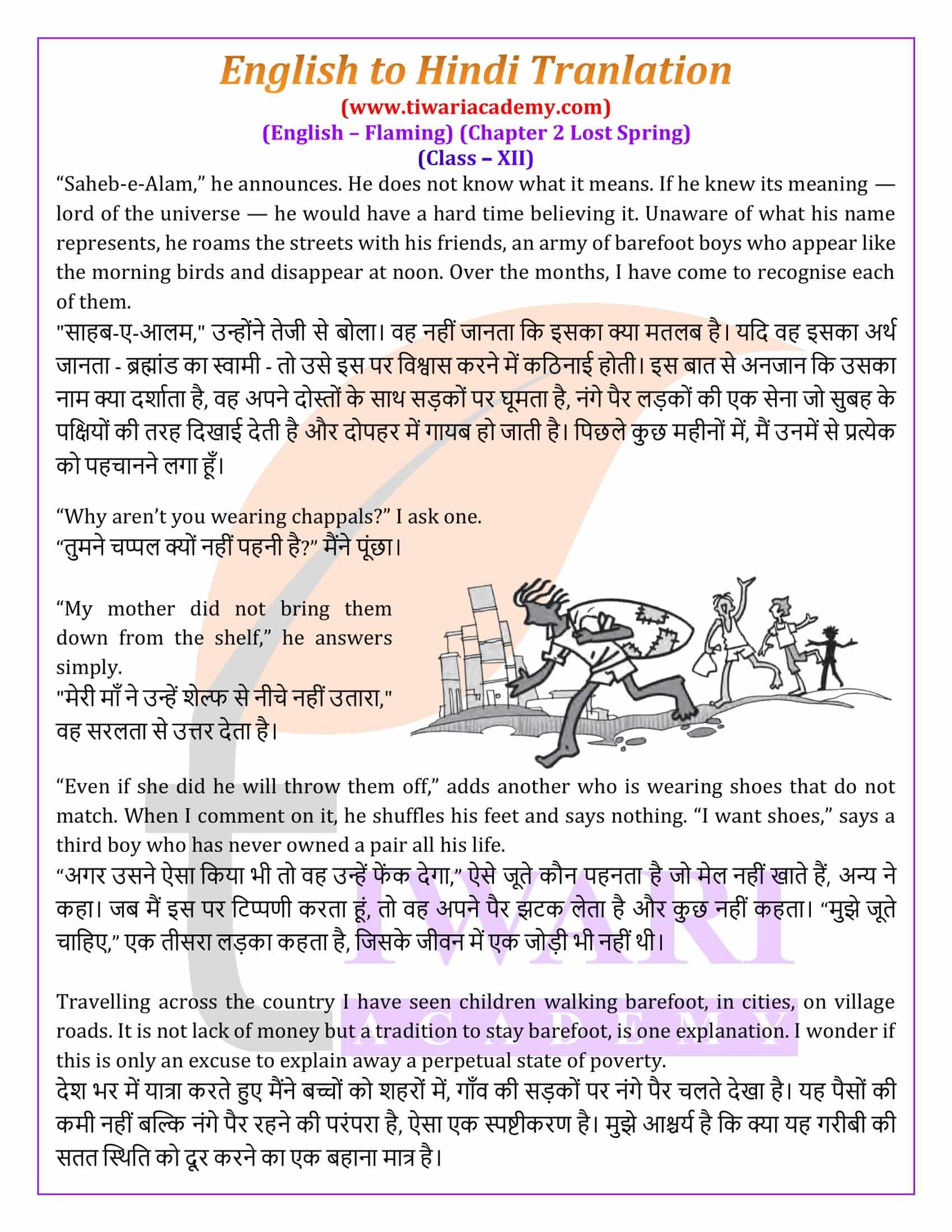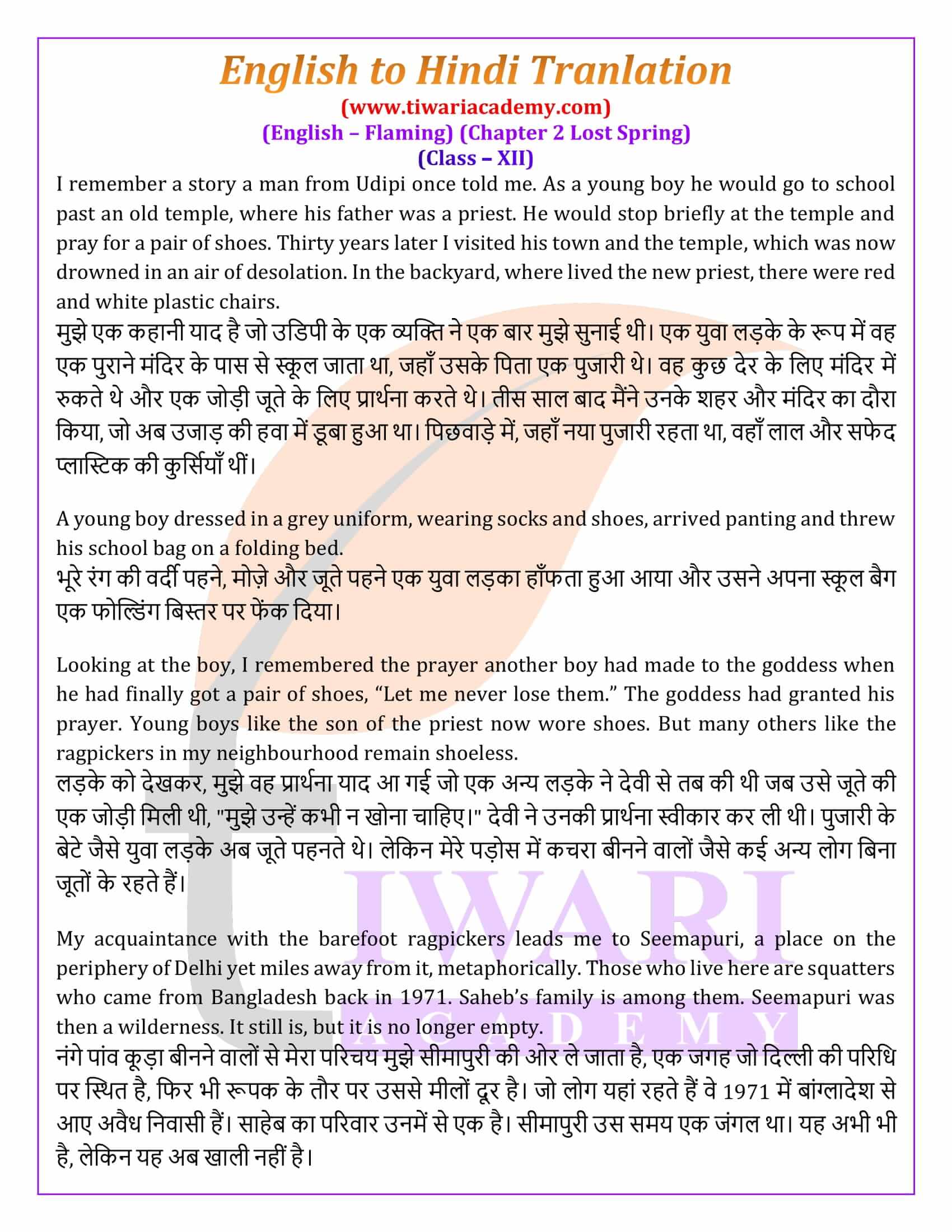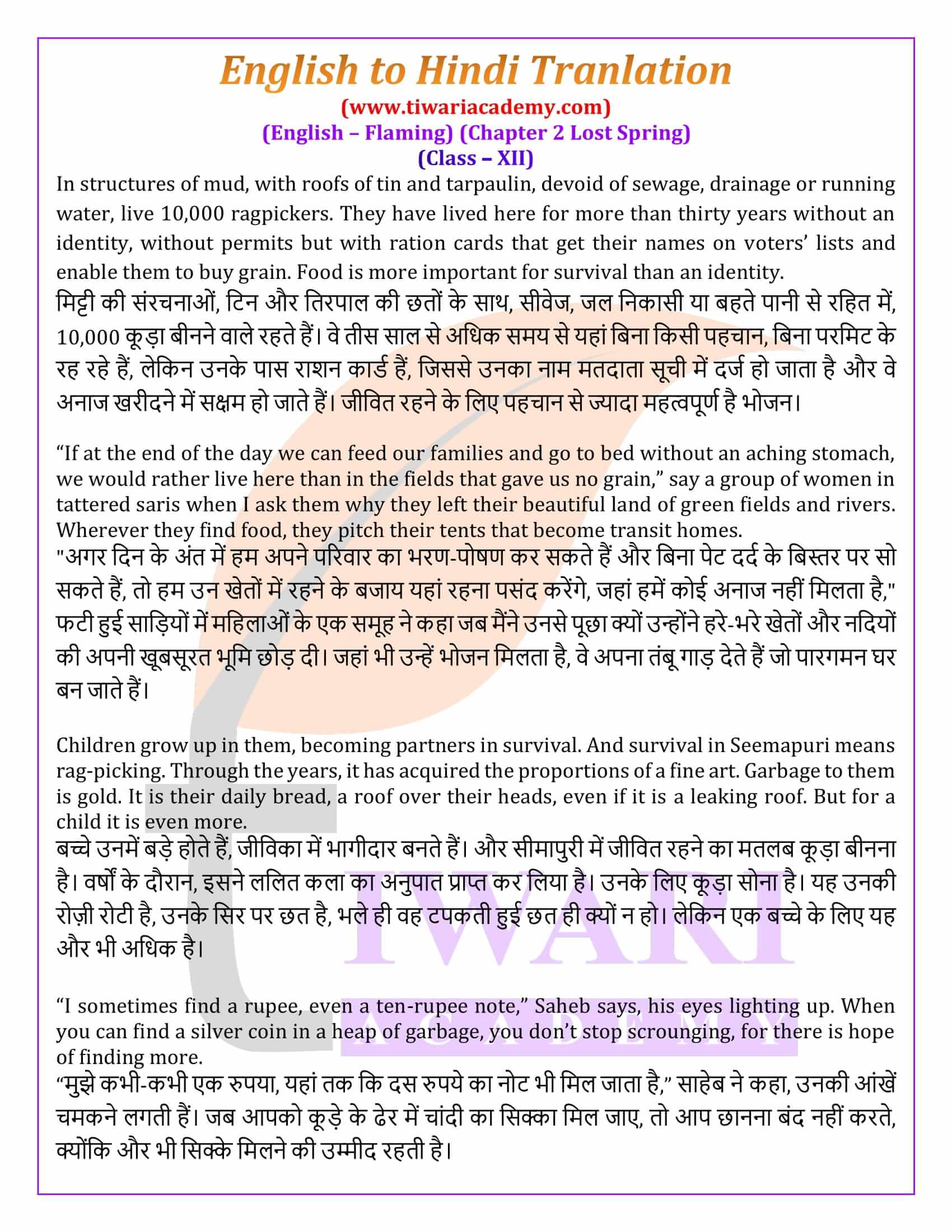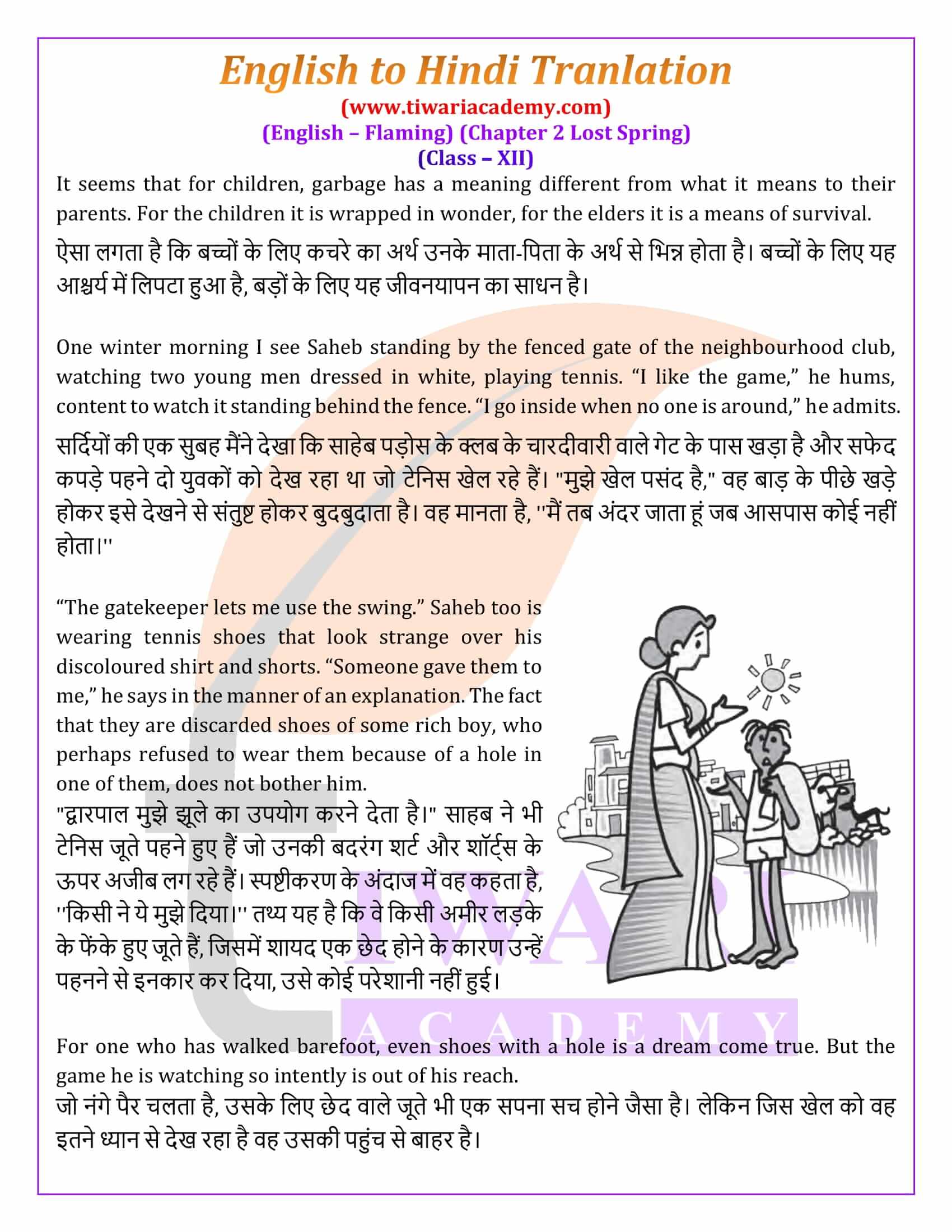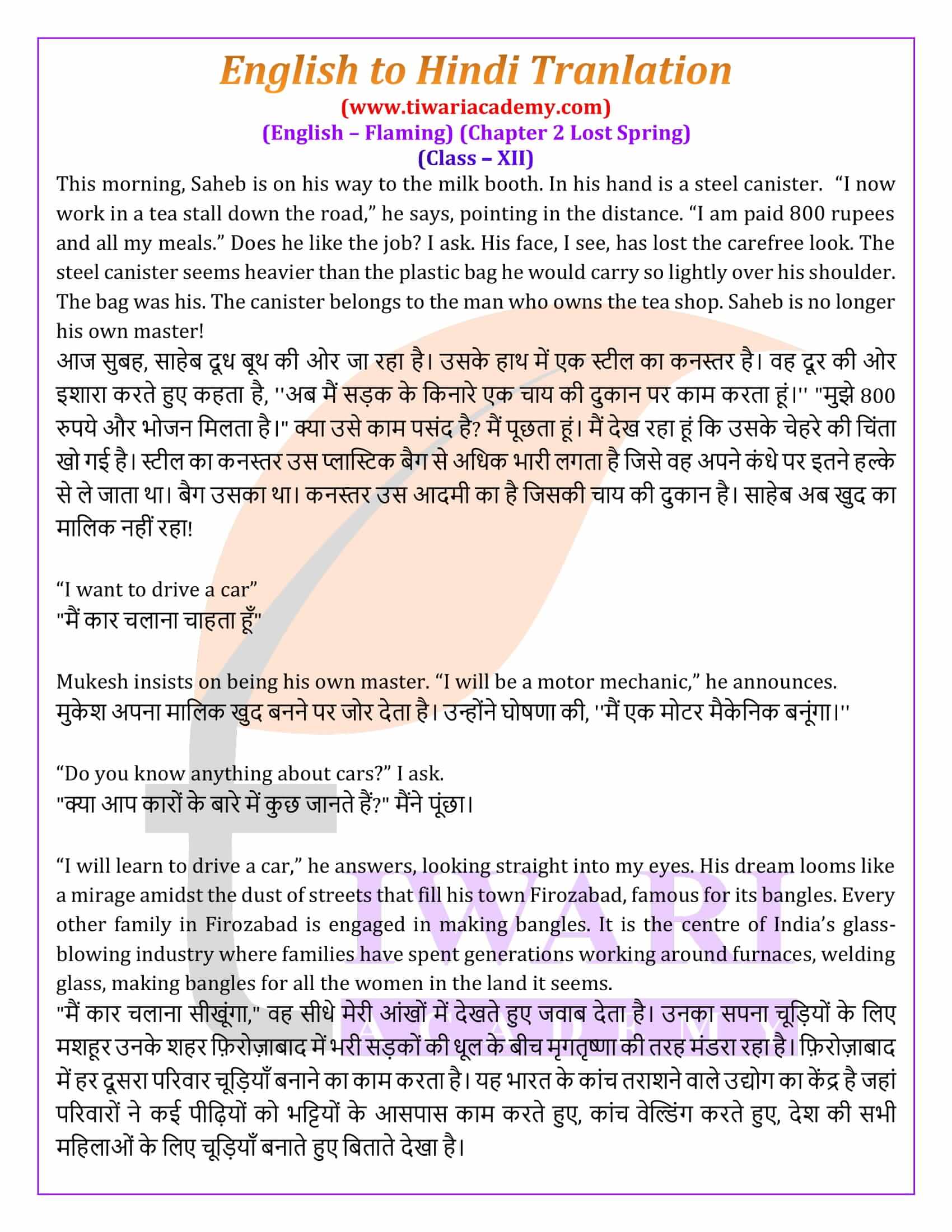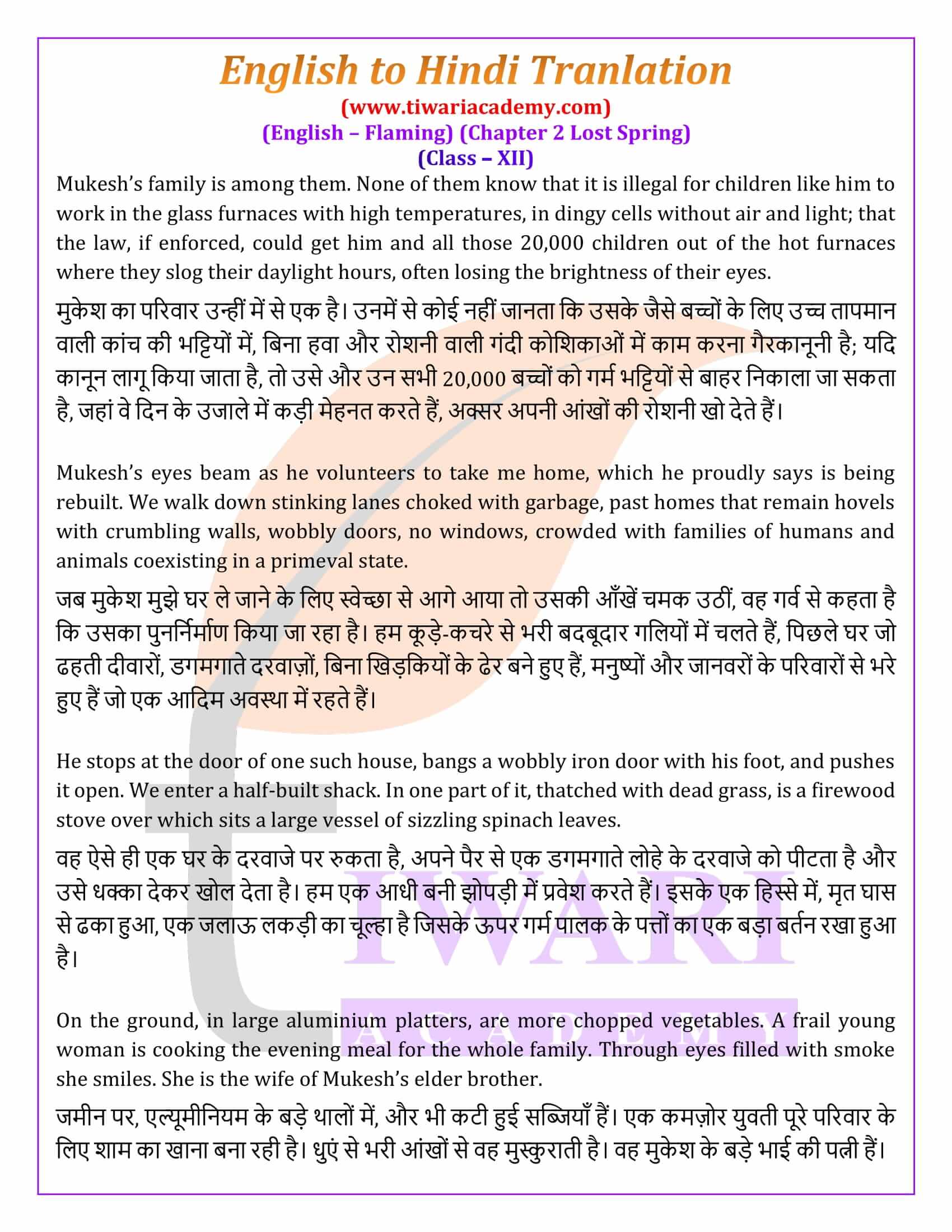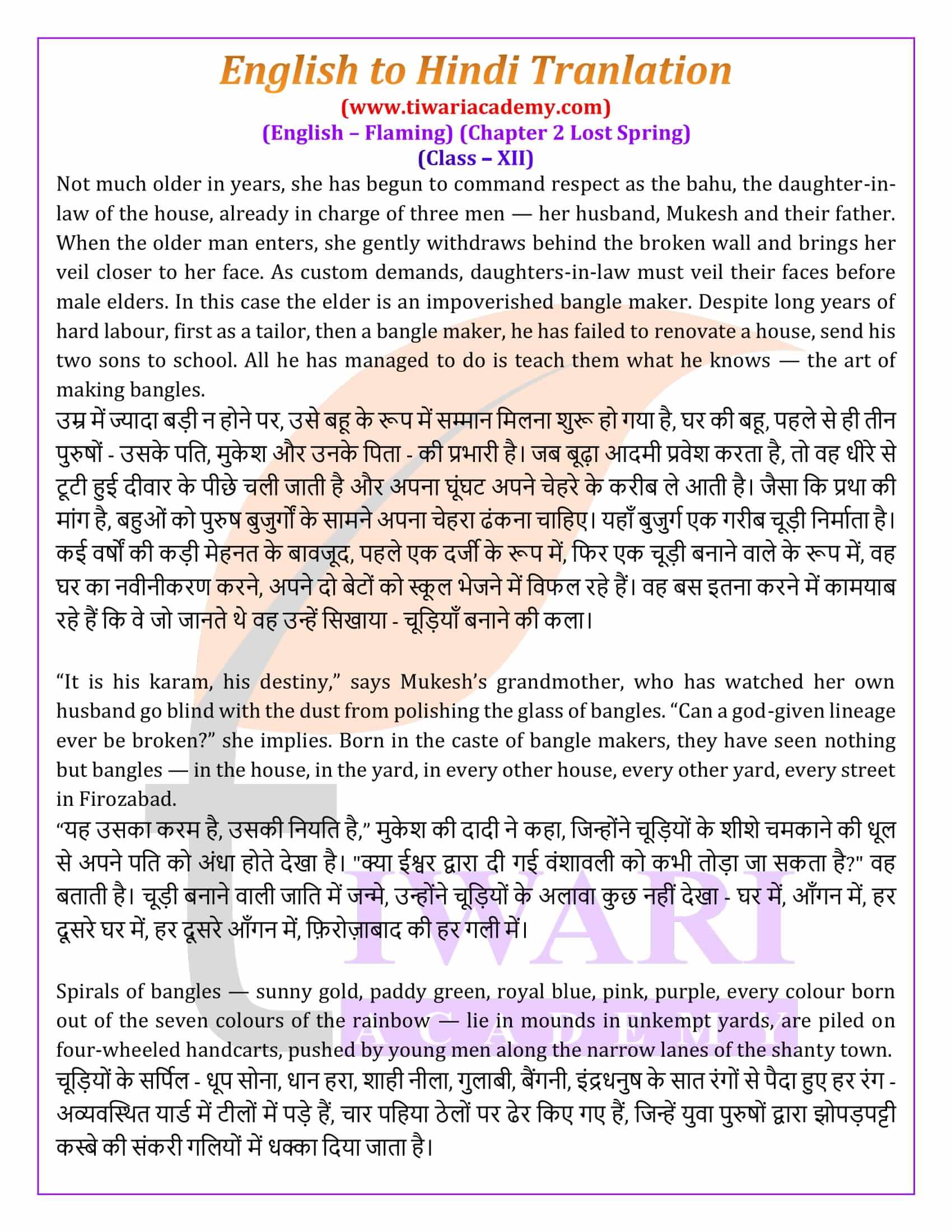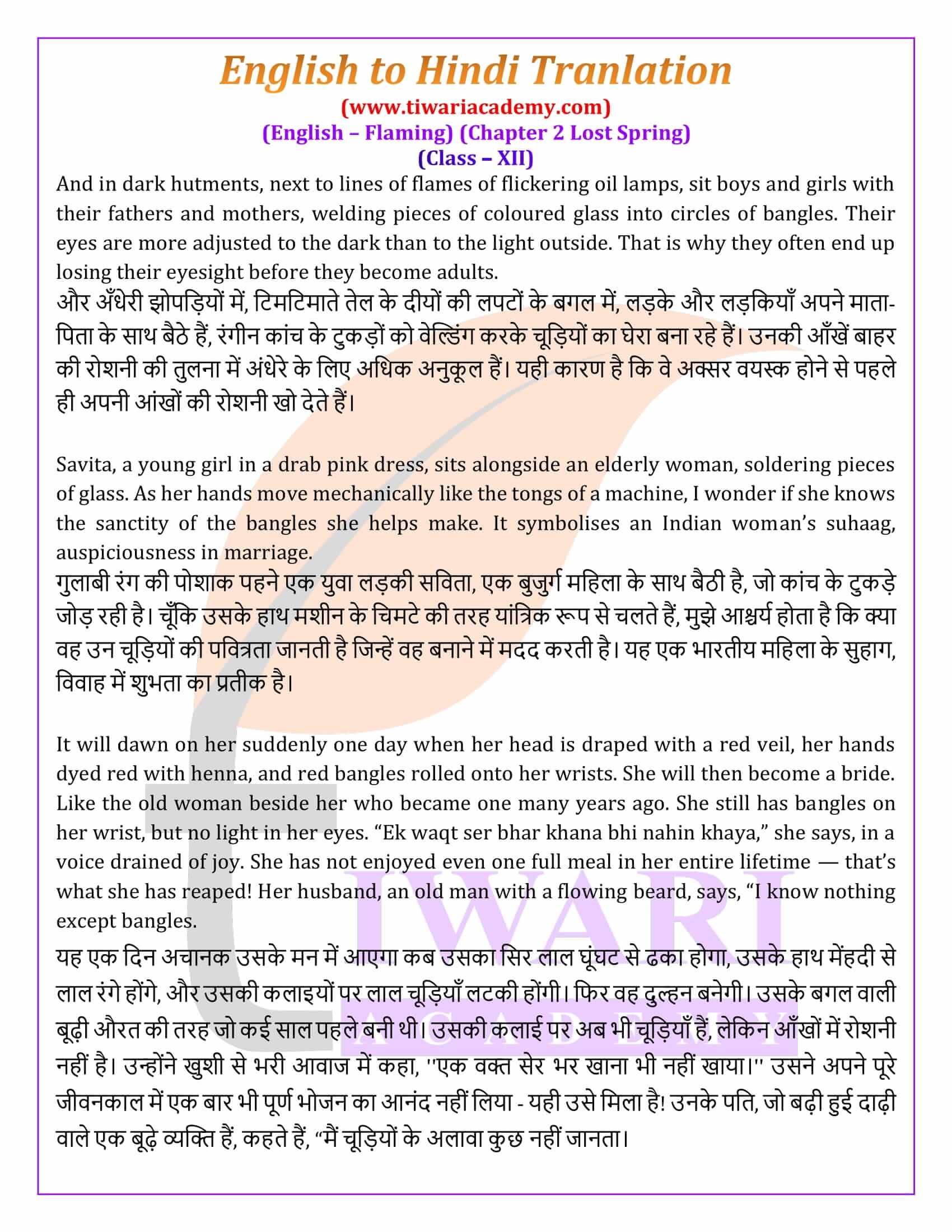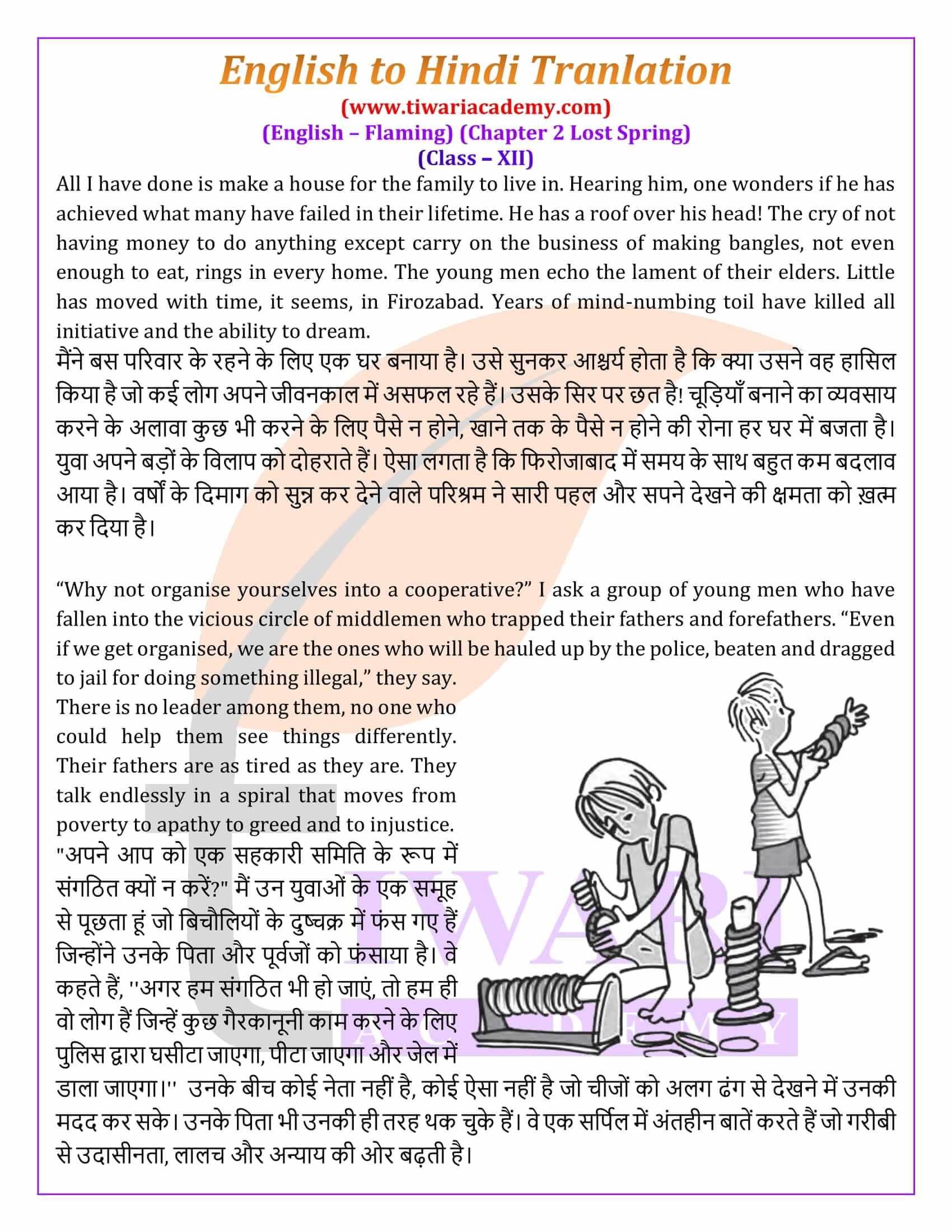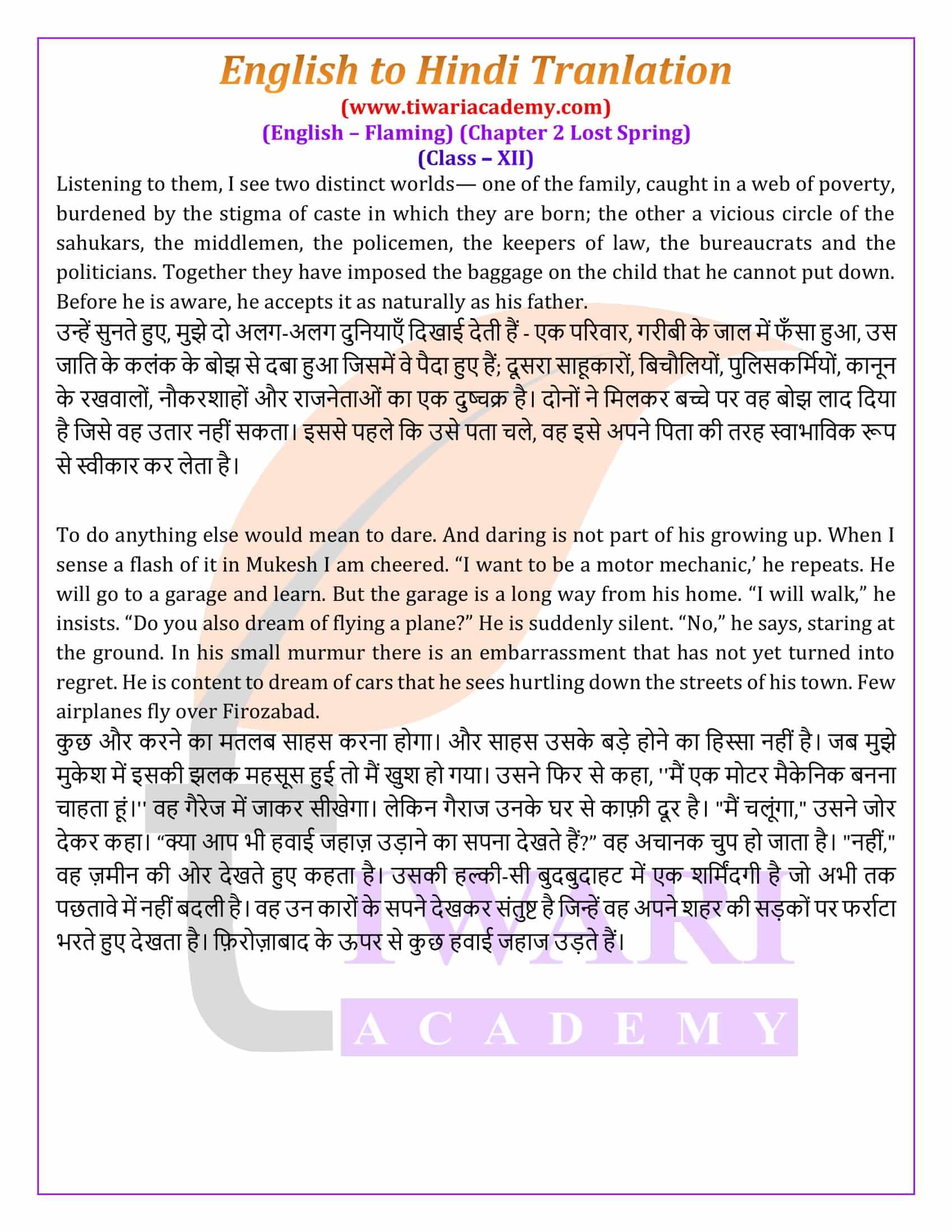NCERT Solutions for Class 12 English Chapter 2 Lost Spring with Hindi Translation Flamingo for academic year 2024-25. For the practice of exams and revision, MCQ, English to Hindi Translation, extra questions of short answer type and long answer type are also given here with answers.
Class 12 English Chapter 2 Question Answers
Think As You Read (Page No. 16)
What is Saheb looking for in the garbage dumps? Where is he and where has he come from?
Saheb is looking for gold in garbage dumps. They search for any valuable item in the junk and then sell it.He came to India with his family from Bangladesh as their farms were badly affected by severe storms.
He is now in Seemapuri constituency of North East Delhi with other families who migrated to India in 1971 when Bangladesh was formed.
Author feels that how easily children not wearing footwear explain that to remain barefoot is a tradition and it is not that they are not wearing shoes because they are poor. He knows that this is just an excuse and they are barefoot because they are poor and she also wonders that this is a great way to hide their poverty. After this incident she also remembers the story of a poor boy who prayed for a pair of shoes.
Is Saheb happy working at the tea-stall? Explain.
Saheb was certainly not happy with his tea stall job because now his freedom was gone. A man is a servant in job; he has to obey his employer or master. And he was no longer the master of his work and his thoughts. As long as he was a rag picker, he had time and freedom for everything. Before working at tea stall and before taking home’s responsibility he used to roam streets all day long with friends and he was delighted in that. Steel canister given by owner of tea stall seems much heavier than the plastic bag he used to carry at the time of rag pick and this weight has taken all his freedom and liberty.
What makes the city of Firozabad famous?
Firozabad was founded by Firoze Shah Tughlaq. The famous city Agra is just 37kms away. Firozabad is famous for bangles and glassware products. The work of bangles in Firozabad is about 200 years old. With which the livelihood of most of the people is related. Even today, bangles are made by hand in the old way and colorful colors are filled in them by hand. Firozabad is also known as “SuhaagNagri” because manufacturing of bangles for entire country is done from here.
Mention the hazards of working in the glass bangles industry.
Working in glass bangles industry is extremely hazardous for both children as well as for adults. The furnaces they work in have extremely high temperature and lack of proper ventilation. Persistently working in low light conditions without any protective eye gear leaves them blind. Even burns and cuts are quite common. The workers are quite prone to ailments such as lung cancer. Thus, the surroundings, prevailing conditions and the type of job involved-all prove risky to the health of the workers.
Understanding the Text (Page No. 20)
What could be some of the reasons for the migration of people from villages to cities?
There are many reasons for the migration of people from the villages to the cities. The primary reason is employment as cities offer better opportunities for youth in industries. On the other hand, better education, medical facilities and infrastructure are some of the other reasons of people switching themselves to cities. But in case of Saheb and his family, they moved from Bangladesh to India for their survival as they were poor and relied totally on farming which got affected by continuous storms and they were about to die of starvation.
Would you agree that promises made to poor children are rarely kept? Why do you think this happens in the incidents narrated in the text?
Indeed the promises made to poor are rarely kept. It’s a lewd joke by the upper class with them. People often show them lucrative dreams and promise to fulfill them but do not take them seriously. We always want to do something for the poor children but doing so is a difficult task to work on. Similar was the case with author Anees Jung making a false promise of constructing a school for Saheb. There is a difference in asking a child why he does not go to school or I will make a one for you. Even though Anees understands the pain of poor children yet when it comes for execution of a plan, it makes all the difference.
What forces conspire to keep the workers in the bangle industry of Firozabad in poverty?
In Firozabad’s bangle industry, there are many forces that keep the workers below poverty line. Businessmen are responsible for this, which attract the poor by luring them with money. And in its greed, they engage their children in this work from a very young age. Government administration is also responsible for this. If they are strict, then no person can work in such a hazardous atmosphere that too for a little money. Even after harming their health, those people are not earning much money. As we read in this chapter about a lady with Savita saying not even a single day came in her life that she slept with a full stomach. Police are also responsible for this because if they follow the law and do not allow illegal activities to run, then no one can operate the way bangle industry is growing in Firozabad.
How is Mukesh’s attitude to his situation different from that of his family?
Mukesh’s future planning was different from his family members and from rest of the city who were involved in carrying on the tradition of carrying forward their family business since generations. A city where everyone considers this work to be a God’s blessing or life’s destiny and wants to take it forward, Mukesh however thinks in contrast to his family. He wants to make his future as a car mechanic and is ready to walk any distance to learn this job.
Thinking about Language (Page No. 20)
Although this text speaks of factual events and situations of misery it transforms these situations with an almost poetical prose into a literary experience. How does it do so? Here are some literary devices:
• Hyperbole is a way of speaking or writing that makes something sound better or more exciting than it really is. For example: Garbage to them is gold.
• A Metaphor, as you may know, compares two things or ideas that are not very similar. A metaphor describes a thing in terms of a single quality or feature of some other thing; we can say that a metaphor “transfers” a quality of one thing to another. For example: The road was a ribbon of light.
• Simile is a word or phrase that compares one thing with another using the words “like” or “as”. For example: As white as snow.
Carefully read the following phrases and sentences taken from the text. Can you identify the literary device in each example?
1. Saheb-e-Alam which means the lord of the universe is directly in contrast to what Saheb is in reality.
2. Drowned in an air of desolation.
3. Seemapuri, a place on the periphery of Delhi yet miles away from it, metaphorically.
4. For the children it is wrapped in wonder; for the elders it is a means of survival.
5. As her hands move mechanically like the tongs of a machine, I wonder if she knows the sanctity of the bangles she helps make.
6. She still has bangles on her wrist, but not light in her eyes.
7. Few airplanes fly over Firozabad.
8. Web of poverty.
9. Scrounging for gold
10. And survival in Seemapuri means rag-picking. Through the years, it has acquired the proportions of a fine art.
11. The steel canister seems heavier than the plastic bag he would carry so lightly over his shoulders.
Answer:
- 1. Irony.
- 2. Metaphor.
- 3. Contrast
- 4. Contrast
- 5. Simile
- 6. Contrast
- 7. Hyperbole
- 8. Metaphor
- 9. Metaphor
- 10. Hyperbole
- 11. Contrast
Talking about Text (Page No. 20)
How, in your opinion, can Mukesh realise his dream?
Mukesh is a visionary person and the dream he has dreams of can come true provided he works hard for it. He wanted to break the shackles of his old tradition of bangles making and do something new which was very important to kick off.He was a hardworking man with good willpower and determination. He didn’t dream in which field he would have to make any investment by himself like a doctor or an engineer but only a mechanic. If he works part time at some shop, then he can become an expert in a few months with his perseverance.
Mention the hazards of working in the glass bangles industry
Working in glass bangles industry is extremely hazardous for both children as well as for adults. The furnaces they work in have extremely high temperature and lack proper ventilation. Persistently working in low light conditions without any protective eye gear leaves them blind. Even burns and cuts are quite common. The workers are quite prone to ailments such as lung cancer. Thus, the surroundings, prevailing conditions and the type of job involved-all prove risky to the health of the workers.
Why should child labour be eliminated and how?
We are strongly against child labor and support its immediate ban. If poor children don’t go to school, they will not get equal rights, which they are deprived of.A child is meant to learn and not earn. They are meant to enjoy all the rights bestowed upon them and have a happy and fulfilling childhood. Child labour impacts the psychological, emotional and physical well-being of a children. It drifts them away from education and becomes an impediment in their way of enjoying a happy and meaningful childhood.
Though Government of India has made laws that prohibit children to work in any industry since several decades but they are not followed properly.They should give free education to the children so that they will be attracted to the school. Aadhar cards of parents sending their children to earn money should be cancelled so that their employment is affected and they are forced to send them to school.
Short Answer Type Questions – Extra Question Answers
- Who was Saheb? How does he meet author Anees?
Saheb was from a poor Bangladeshi family who had taken refuge in India due to natural disaster in his country. He was a rag picker because he had neither work nor purpose in life.
Anees used to find Sahib in morning while searching for something in the garbage heap in her neighborhood. She took pity on his pitiable condition. - Why author ask this question “why do you do this” after seeing this Saheb for the first time?
She asked this because she felt very sad for Saheb while he was searching for something in the garbage. She felt what a small child was doing in the dirt at the age of studies and sports. It was her way to start conversation with him as she wanted to know more about him. It was easy for her to see elders doing rag picking but not a child. - What did Saheb search everyday in the garbage?
Saheb and his friends used to get money and sometimes silver in Garbage.Saheb and other poor children used to search this free money very eagerly in garbage. This used to help their family a little. And sometimes he used to get very valuable items too which kept him greedy. His family was so poor that they did not even have money to start any work on their own.And this was the condition of all Bangladeshi people who left their homes and were settled in Seemapuri. - What did the author promise to Saheb? Why couldn’t she fulfill it?
Seeing Saheb and other children roaming around the whole day on streets, the author promised that she will build a school and asked them to join for studies. Saheb believed her words and dreamed of school. But this was said just like that by author, she was not serious at all.After a few days when both met, Saheb asked about the school. Author was embarrassed as she was not intended to open any school. - Why has the author called Saheb’s life a Bleak World?
Ans: Bleak world is a colorless world with no hope. The world of children like Saheb is exactly the same. They do not have a bright future because neither they can afford education nor government looks after them from a second glance. It is not their fault that they were born in poverty, but showing them a new path and providing them equal opportunities in society should be the first priority of the government.However, government looks towards them from the view point of vote bank only. Due to all these reasons, their next generation is also engaged in poverty, hunger and such activities.
How does the author describe the area of Seemapuri?
According to the author, Seemapuri has been like a forest for the last several decades. Over time, the population has grown but a decent number of people here are refugees from Bangladesh who left their country post creation of it. The area is slum with structures of mud with roofs of tin and tarpaulin. The dirty water of sewage flows near the settlement of those people.Garbage piles are near their house and stray animals roam in it throughout the day.
Why did the children not wear any footwear? What justification did they give for it?
Children were too poor to afford footwear. The children gave many justifications for not wearing slippers. Somebody said his parents don’t buy for him while other said that it was their tradition to move bare-footed.The truth was that they had now got used to roam like this.Sometimes not wearing slippers or torn old clothes becomes a way of showing the poverty and troubles. And when it is a compulsion not to wear slippers for one, then fellow children also copy that trend and they are unaware of the harm.
Why author called garbage as “Gold”?
Author Anees Jung called garbage as gold for Seemapuri migrants because gold is one of the precious metals of world. Since many centuries any valuable item is compared with Gold only. Gold can be converted into cash anytime by any anyone and cash can be redeemed to meet daily needs. Any kind of metal, plastic, electrical goods or anything found in the garbage is not less than gold for them. They sell them in open market for cash which meets their square meal of the day. And sometimes they get really gold or even silver because many electrical and electronic items have a small portion of silver in it.
Class 12 English Chapter 1 Very Short Answer Type Questions
- If migrants of Seemapuri settled due to natural disaster then why didn’t they go back later?
There are many reasons why Seemapuri migrants didn’t go back to Bangladesh. First, they got means of survival in Delhi. Along with their livelihood, they also got a temporary residence. Second, the government has made arrangements for them like ration cards which help them to buy food grains at subsidized rates. Last but not least they were also afraid if they go back, they will have to start everything from scratch. And there would be no arrangement for their food or anything else. - Which sport did Saheb like? Did he get a chance to play that?
Saheb-e-Alam loved tennis a lot. He used to watch this game from outside the tennis court. He was not allowed inside during the game but the gatekeeper let him in after the game was over.And for him swinging those swings was also a great pleasure to experience. He was not allowed to play tennis because he was not a member of academy. - What was Saheb wearing one morning? Where did he get it?
Saheb was wearing tennis shoes given by someone. Those shoes might have belonged to some rich boy who had stopped wearing them.Saheb was very happy and he didn’t care that there was a hole in one of those pair of shoes. If someone who has spent a large part of life barefoot, it does not matter how old or torn the shoes given to him. Such poor children wear such shoes or clothes until they are raged and they are no longer fit to wear. - Why does garbage have different meanings for elders and younger?
Garbage is a means of livelihood for elders because they have the responsibility of their home and children. They have already lost everything in their own country, if they don’t do rag picking here every day, then the survival will be difficult. For children this work is like entering a new world where they get something new everyday. Sometimes it is money and sometimes its metals or toys for them. Sometimes they get something for themselves, sometimes for the elders, which they sell and run their house.
Class 12 English Flamingo Chapter 1 Question Answers for Exams
What kind of job did Saheb get? Was he happy?
Saheb got a job at a tea shop for eight hundred a month. His job was to go on foot and bring milk in a canister. He no longer was needed to scrounge gold in garbage anymore as he got a permanent job with lot of responsibilities. And under the burden of this responsibility, he did not seem happy at all because now his freedom to roam the streets was over. He lost his childhood fun soon when he started working.
How according to Anees Jung, plastic bag of garbage lighter than a steel canister on the delicate shoulders of childhood?
Seeing the sadness on Saheb’s face, the author realized that even though he is now earning by himself. Still he isn’t happy as happy and excited as he was in rag picking. As a child, he had the freedom to work in a cool environment under the open sky, which was not there now. In the job he had to listen to his master, follow his instructions then only he was paid. As soon as he grew up, the burden of responsibilities came on him.The weight of the steel canister in front of this burden was much lighter than what he used to carry.
Tell us something about the city of bangles.
Firozabad is known as the city of bangles. Firozabad was founded by Firoze Shah Tughlaq. The famous city Agra is just 37kms away. Firozabad is famous for bangles and glassware products. The work of bangles in Firozabad is about 200 years old. With which the livelihood of most of the people is related. Even today, bangles are made by hand in the old way and colorful colors are filled in them by hand. Firozabad is also known as “SuhaagNagri” because manufacturing of bangles for entire country is done from here.
Did Mukesh’s family know that working in a high temperature furnace is illegal for children?
Not only Mukesh but everyone in Firozabad involved in this work did not know this. They didn’t know how hazardous this work is for them. Sending children to earn money in such a dangerous work is like risking their lives but they have been doing so since generations. Over 20,000 children were involved in glass blowing industry in Firozabad and unfortunately their parents and grandparents believe this work as god gift and their destiny. Doing the same work for years, their mentality had become such that they did not find anything illegal in this work. They strongly believe that its God’s custom which should not be broken.
What were Mukesh’s dreams?
Mukesh’s dream was to become a car mechanic.He belonged to the city where every other person was involved in the glass making or furnace industry but he wanted his future different.Not that he wanted to become a mechanic keeping health in mind, but becoming a mechanic was his interest.He was ready to work hard for it and one day wanted to become a car expert himself.
Why is the glass manufacturing industry illegal for children?
Children working in these factories often end up losing their eyesight before they become adults as they have to work in the dark all the time. The dust that comes from polishing the glass of bangles badly affects the eyes and the lungs which lead to losing eyesight and respiratory disorders. Indian Government has also taken some positive steps in this direction. Also, several social programs for the rehabilitation for children who are rescued from child labour are run at the central and state level. In recent years, there has been a major emphasis on providing basic education for all children, which is a long-term answer to this social menace.
Why they are still empty stomach though they are working & earning from bangles making since generations?
This work is not enough to make them rich or empowered. By putting their health at stake, they get little money from bangles making that they can hardly survive. We read about a woman in this story who says “she has not enjoyed even one full meal in her lifetime”. This shows how many difficulties they face and make their living.
How has the author described Mukesh’s house and his locality?
Mukesh lived in a slum area. A place where both humans and animals live in the same place together.There were huge piles of garbage and a very foul smell was coming from the filth.Unaware of this, they live in a world where they can get so many diseases from this filth. This is perhaps the reason why they don’t live a long life. There were kuchcha homes in that colony made of mud and cow dung. That place was not fit for humans in any way, but people living below the poverty line had no other choice.
- Who was Savita? What was her job?
Savita was a young girl in Mukesh’s locality in Firozabad. Her job was to make glass bangles like any other person involved in this industry. Coming into this terrible work at a young age, she was unaware of what these bangles are used for and its importance in Hindu weddings. According to author, Savita was very good at her work because she was working in similar trade for a quite long time now. Now she has a gleam in her eyes and enthusiasm for work, but by the time she learns the visual effects of this work, it will be too late. - How does the author ask to unite against the exploitation of sahukars?
Seeing the labor working in the glass industry of Firozabad, Anees appeals to them to unite and bring this fight together. She feels that it will be difficult to win this battle alone and if this continues, the future of the children of this city will always be in the dark.After talking to people, she felt that people have no hope of getting out of this life because they have accepted it as fate.She asks them to form a cooperative and fight against local administration, bureaucrats, politicians and others who have created a vicious circle for them and their future generations. - Do the people of Firozabad unite against child labor after being influenced by Anees’s words?
Though people agree with Anees’s words but they find it an impossible task to fight against it. There are two reasons behind this. First, this is their means of livelihood. Their kids have been supporting them from a young age if they don’t send them to the factory, how will they run the house?
Second, if they unite then the police will beat them up and put them in jail for wrong doings. But what they do not tell the author and the main reason is that they do not have any great leader who can lead them in this mission. Instead of fighting this battle, they talk endlessly about poverty, hunger and injustice. And this is the reason that even today they are standing where their forefathers were.
Class 12 English Flamingo Chapter 1 Long Answer Type Question Answers
Why is the story of Saheb&Mukesh called lost spring?
The childhood of Saheb and Mukesh is called spring because spring is a season. The spring season gets its name from the verb “spring.” It’s a nod to the flowers and plants springing up, springing open, and bursting into blossom. Same way a child also a child is born, his mental and physical development takes place and then he reaches to adolescence. Children need constant attention and guidance specially in early years of life.Most of their mental development takes place at this age.When children work in factories, they are deprived of school which is the foundation of child’s success. The flower of their childhood does not bloom and if that happens then the future of the nation is dark. Although a lot is said and written about the development and activities of children, but author Meta Lander in his book “Blossoms of Childhood” has written that 90% of brain development takes place by the age of 5. Saheb & Mukesh both were affected by circumstance and luck respectively. Both were deprived of that good phase of childhood as they had to work at a young age to financially support their families.Rag picking and working in the glass furnace industry has a very dangerous effect on health. Surroundings, prevailing conditions and the type of job involved-all prove risky to the health of the workers.Working in hot conditions can be hazardous to health. Effects range from discomfort or heat rash to heat exhaustion or heat stroke which can cause permanent injury or death. Heat stress can occur without the worker being aware of how much they are affected until it is almost too late. Those who exploit by showing greed for money at a young age never think about health and future. It is often said that “every child is a different kind of flower and together make this world a beautiful garden”.
According to you, who are the other migrants who took refuge in India and are forced to live a life like a Saheb?
People from many countries migrate to India for various reasons. Like,Thousands of Nepalese migrate to India every year due to absence of fruitful local employment in their country. Migration of people from Nepal to India is also due to a Peace & Friendship treaty signed between two Nations in 1950 to establish strategic relationship between the two South Asian neighbors.
But primary reason is due to poverty, unemployment, declining natural resources and also the Maoist insurgency, migration has become an important livelihood strategy in Nepal. Sikkim has the highest density of Nepalese as compared to any Indian state. We can see them working hard in Food & Beverage and housekeeping industry majorly in most of our states. Like Bangladeshis, they too get engage in such works from a young age and their sufferings are like that of any poor African country. Despite being hard worker they remain below poverty line and suffer serious problems like rag pickers of Seemapuri.
How can the exploitation of children in the glass industry of Firozabad be stopped? Do you agree with the steps taken by the government?
The exploitation of children can be stopped via various means in Firozabad’s glass and bangles industry. NGO’S which are already working extensively towards eradication of child labor from shops, factories and other menial works should work aggressively with famous and respectful celebrities of civil society appealing for boycott of children from said work. Celebrities can influence the public by communicating in an effective way. Secondly, We should send more and more children to school. India has the world’s largest educational system, yet faces the hurdles of low literacy, due to low enrollment. Recently some organizations have come to the fore which have taken a commendable step towards nomination of kids in schools. Education is a crucial component of any effective effort to eliminate child labor. In India, about 1.4 million child labors are in the age group of 7-14 years. What is more concerning that these kids can’t even write their names. This is all because of lack of education. The basic reason for child labor is poverty, illiteracy, and unemployment. People who are illiterate do not send their children to school. Instead of sending them schools, they force them to earn money. Thus, small children cannot get the education, as a result, they lack behind in their life. Last but not least, there should be effective implementation of laws. Though government at their respective state and central level have made several laws to stop child labor but that’s not enough. There are serious gaps in implementation of these laws. And these gaps have become possible because of relaxation from middlemen, police, local administration, industry association and others. As we saw in this story that people do not want to be united in this campaign.Unless the government makes right coordination at district levels strictly enforces them, it is difficult to implement it properly.
